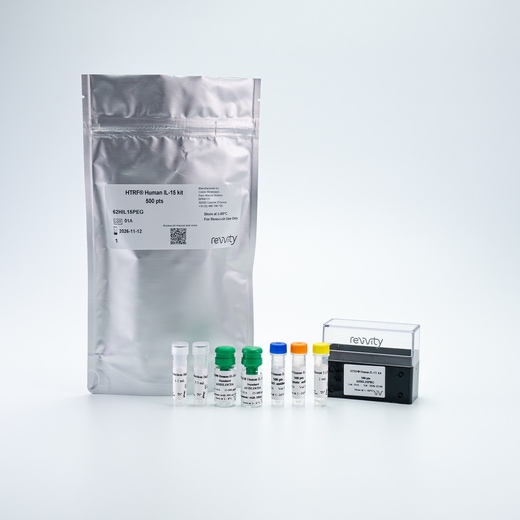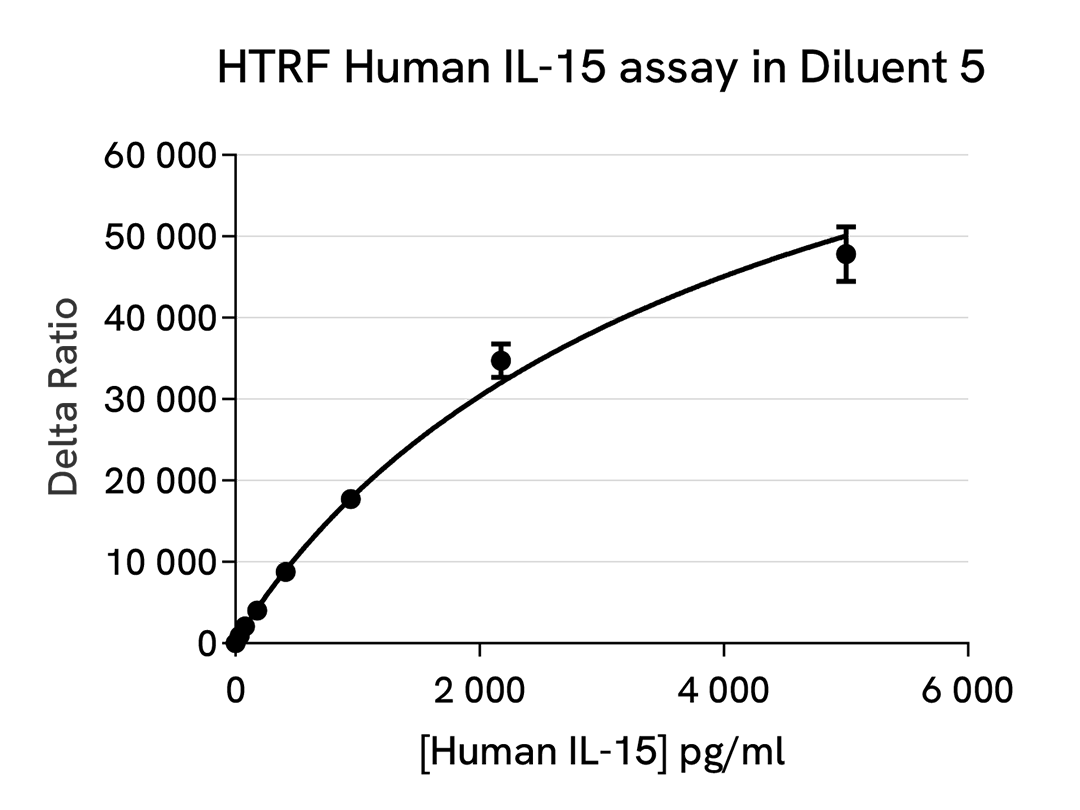

HTRF Human IL-15 Detection Kit, 10,000 Assay Points

HTRF Human IL-15 Detection Kit, 10,000 Assay Points




The HTRF Human IL-15 kit is designed for the quantification of human IL-15 release within cell supernatants.
| Feature | Specification |
|---|---|
| Application | Protein Quantification |
| Sample Volume | 16 µL |
The HTRF Human IL-15 kit is designed for the quantification of human IL-15 release within cell supernatants.


HTRF Human IL-15 Detection Kit, 10,000 Assay Points


HTRF Human IL-15 Detection Kit, 10,000 Assay Points


Product information
Overview
Human Interleukin 15 (IL-15) is a cytokine that is initially produced as a precursor that matures into a 114-amino acid glycoprotein. IL-15 is generated by multiple tissues, including the placenta, skeletal muscle, kidney, lung, heart, and monocytes/macrophages. IL-15 acts mainly on T and B cells and is a key cytokine in the development, proliferation, and survival of natural killer cells.
IL-15 binds with high affinity to the IL-15 receptor α and forms a complex with the α and γ chains of the IL-2 receptor for signal transduction. It can regulate inflammatory responses and activate NK cells during immune responses. IL-15 signaling has become a focus of interest for therapeutic interventions, especially in autoimmune diseases such as inflammatory bowel disease, systemic lupus erythematosus, inflammatory synovitis, psoriasis, diabetes mellitus, asthma bronchiale, rheumatoid arthritis, and T-cell leukemia.
Specifications
| Application |
Protein Quantification
|
|---|---|
| Brand |
HTRF
|
| Detection Modality |
HTRF
|
| Product Group |
Kit
|
| Sample Volume |
16 µL
|
| Shipping Conditions |
Shipped in Dry Ice
|
| Target Class |
Cytokines
|
| Target Species |
Human
|
| Technology |
TR-FRET
|
| Unit Size |
10,000 assay points
|
How it works
Assay principle
Cell supernatant, sample, or standard is dispensed directly into the assay plate for the detection by HTRF® reagents (384-well low-volume white plate or Revvity low-volume 96-well plate in 20 µl). The antibodies labeled with the HTRF donor and acceptor are pre-mixed and added in a single dispensing step, to further streamline the assay procedure. The assay can be run in up to a 1536-well format by simply resizing each addition volume proportionally.

Assay details
Standard curve
The IL-15 standard curve is generated in the assay Diluent 5, provided in the kit.

Assay specifications
| Sample size | 16 µL |
|---|---|
| Final assay volume | 20 µL |
| Kit components | Lyophilized standard, frozen detection antibodies, buffers & protocol |
| LOD & LOQ (in Diluent) | 4 pg/mL & 10 pg/mL |
| LOD & LOQ (in RPMI +10%FCS) | 8 & 10 pg/mL |
| LOD & LOQ (in DMEM +10%FCS) | 16 & 20 pg/mL |
| Range | 33.8 – 5000 pg/mL |
| Time to result | Overnight at RT |
| Correspondance to I.S. | NIBSC (95/554) value (IU/mL) = 0,013 x HTRF hIL-15 value (pg/mL) |
| Species | Human only |
Analytical performance
Intra and inter assay
Intra-assay (n=24)
|
Sample |
Mean [IL15] (pg/mL) |
CV |
|---|---|---|
|
1 |
97 |
5% |
|
2 |
985 |
5% |
|
3 |
2 353 |
4% |
|
|
Mean CV |
5% |
Each of the 3 samples was measured 24 times, and the % CV was calculated for each sample.
Inter-assay (n=4)
|
Sample |
Mean [IL15] (pg/mL) |
CV |
|---|---|---|
|
1 |
78 |
|
|
2 |
411 |
|
|
3 |
2 174 |
6%5%4% |
|
|
Mean CV |
5% |
Each of the samples was measured in 3 independent experiments (3 days), and the % CV was calculated for each sample.
Dilutional linearity
The excellent recovery percentages obtained from these experiments show the good dilution linearity of the assay. Samples were HUT-102 supernatants serially diluted in RPMI medium.
|
Dilution factor |
[IL-15] expected (pg/mL) |
[IL-15] measured (pg/mL) |
Dilution recovery |
|---|---|---|---|
|
Neat |
- |
153 |
|
|
2 |
76.5 |
70 |
92% |
|
4 |
38.3 |
34.8 |
92% |
|
8 |
19.1 |
19.8 |
105% |
|
16 |
9.6 |
10.2 |
105% |
|
|
Mean CV |
|
98.5% |
Antigen spike recovery
Recombinant cytokine was added to HUT-102 supernatant samples, and the measured response was compared to the calculated expected values. The 100% of recovery indicates similar measurements of cytokine from sample and the kit standard.
|
Sample |
[IL-15] spiked sample (pg/mL)
|
[IL-15] standard (pg/mL) |
Expected (pg/mL) |
Measured (pg/mL) |
Recovery |
|---|---|---|---|---|---|
|
1 |
400 |
144 |
544 |
511.2 |
94% |
|
72 |
472 |
437 |
93% |
||
|
2 |
100 |
144 |
244 |
254.2 |
104% |
|
72 |
172 |
169 |
98% |
||
|
|
Mean CV |
|
|
|
97.3% |
Cross-reactivities
Cross reactivities were assessed using recombinant proteins from the IL2 cytokine family, and tested at 100 ng/mL. Signals were interpolated on the assay standard curve to interpolate concentrations. The assay is human specific, as mouse IL15 cytokine was not detected using this assay.
The possible interference from human Interleukin 15 Receptor alpha / Fc Chimera (IL15 Rα) was investigated. No interference was observed up to 50 ng/mL for IL15 Rα.
|
Tested protein |
Cross reactivity |
|---|---|
|
Human IL-15 |
100% |
|
Human IL-2 |
0% |
|
Human IL-21 |
0% |
|
Mouse IL-15 |
0% |
|
Tested protein |
Interference |
|---|---|
|
IL-15R-Fc |
No interference |
Assay validation
Modulation of secretion of human IL-15 in NCI-H2172 cell line
NCI-H2172 cells plated at 50 kcells/well were stimulated for 48 h with PMA 10 ng/mL, IFN Ɣ 10 ng/mL, or with both compounds for 48H. 16 µL of supernatants were then transferred into a white detection plate (384 low volume) to be analyzed with the Human IL-15 Assay. As expected, treatment with PMA and IFNƔ induced IL-15 production and secretion (IFN-γ Induces IL-15 Trans-Presentation by Epithelial Cells via IRF1 J Immunol (2022) 208 (2): 338–346.)

Validation of HTRF human IL-15 kit on HUT-102 cell line
HUT-102 human cutaneous T cell lymphocyte cells were cultured at a cell density of 2x106 cells/mL in RPMI medium with 10% FBS for 24H at 37°C for supernatant generation to be analyzed by the Human IL-15 HTRF assay. The IL-15 concentration in HUT-102 cell supernatant was 153 pg/mL. These results are in accordance with the literature (Blood (1998) 91 (11): 4265–4272).

Interference with IL-15 receptor
The HTRF human IL-15 assay is able to detect monomeric IL-15 in presence of a large excess of IL-15 Receptor.

SDS, COAs, Manuals and more
Are you looking for technical documents related to the product? We have categorized them in dedicated sections below. Explore now.
- LanguageEnglishCountryUnited States
- LanguageFrenchCountryFrance
- LanguageGermanCountryGermany
- Resource TypeManualLanguageEnglishCountry-


Recently Viewed

How can we help you?
We are here to answer your questions.








































